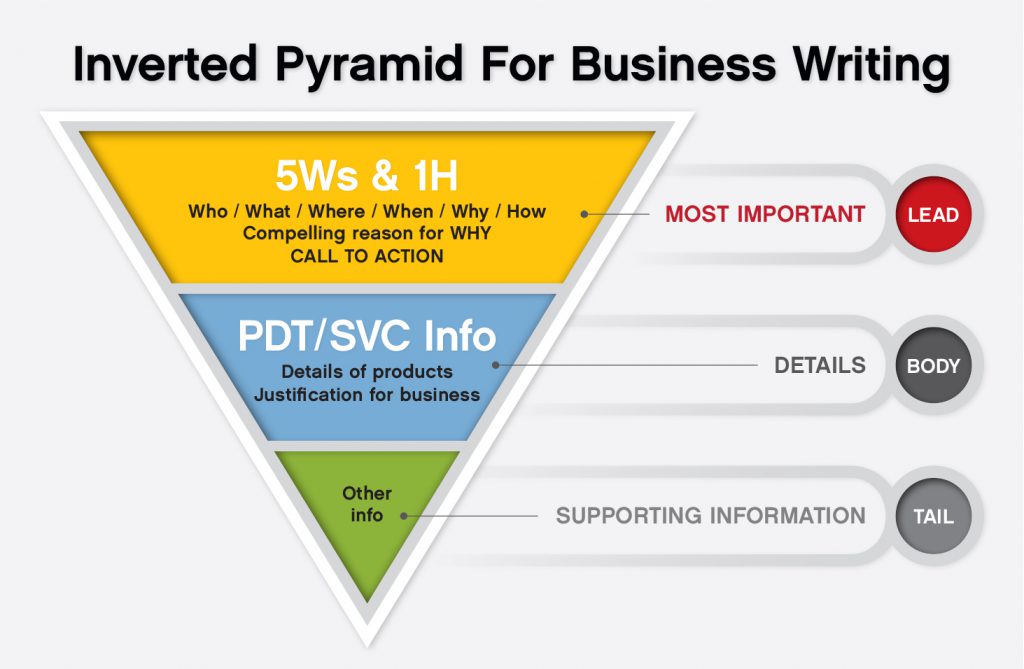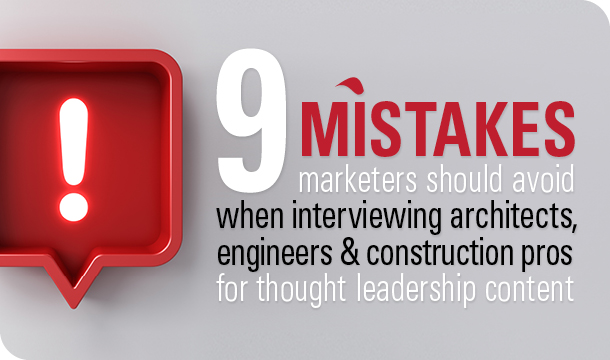9 mistakes marketers should avoid when interviewing architects, engineers and construction pros for thought leadership content
So you read our guide on improving your subject-matter-expert interviewing skills and now you think you’re ready to rock your next thought leadership interview. If you follow our advice, you probably are. But even though you know what you should do, you also need to know what you should not do to get the best, juiciest, most innovative ideas and quotes from the architect, engineer or construction pro you’re speaking with.
A good interviewer knows how to get their subject talking without getting in their way. But there’s a lot more to being a good interviewer than just being a good listener. Do you think Oprah showed up to the vineyard to interview Meghan and Harry empty-handed?
The answer is no: the queen of interviews definitely spent hours with her team arming herself with background information and a hefty list of questions designed to pull out those jaw-dropping soundbites that plastered headlines for weeks afterward.
I can’t teach you to be Oprah, but I can help you optimize your interviewing strategy by avoiding these nine mistakes.
1. Showing up uneducated
Regardless of the subject matter, you should always do your due diligence by thoroughly researching the topic before the interview. If the topic is especially technical, which is common in the architecture, engineering and construction (AEC) world, your preparation is even more important. You don’t want to frustrate the designer by wasting their time having them explain basic concepts — you should show up with at least a base-level understanding on the subject so you can effectively extract the information needed for your content.
Consider the audience of the content you aim to create and try to educate yourself at least to their level of knowledge on the subject. Ultimately, you need to connect with that audience, so putting yourself in their shoes will help you find the questions you need to ask. Which brings me to my next point…
2. Not preparing questions in advance
This goes hand-in-hand with doing your research before the interview. While you are researching the topic, you should also be writing questions down as you find information that piques your curiosity or seems like it would be of interest to the audience. However, make sure you’re asking questions that will tie into or improve your content — a good question can elicit an answer from three to 10 minutes long. Don’t waste precious interview minutes on irrelevant information.
Mark which questions need examples or anecdotes, then set yourself up with follow-up questions when appropriate. While a skilled interviewer like Oprah can come up with off-the-cuff follow-up questions, it’s better to come prepared than rely on your improv skills.
3. Suggesting answers and asking yes-or-no questions
As a rule of thumb, all of your pre-written questions should be open ended. These questions are intended to coax the subject-matter expert (SME) to talk at length on the subject, giving you juicy quotes and useful information to incorporate into your content.
Yes-or-no questions, on the other hand, are self-confirming. They provide an answer and give the interviewee two options: affirm or deny. A yes or no question is one step away from suggesting answers, which you should never do, even if you think you know the answer. You don’t need to prove your knowledge on the topic to your architect, engineer or construction manager — for the purposes of the interview, you’re better off asking them to explain something like you’re five years old rather than putting words in their mouth.
However, yes or no questions can be very useful for clarifying information.
A clarifying yes or no question might look like this: “So if I understand your point, X means Y? Is that correct?” A question like this invites the SME to provide examples or additional information that might clear up their previous answer.
4. Failing to provide the context and goals of the interview
It’s important your interviewee understands why they’re being interviewed, the goals of the content you’re creating and its intended audience. This might seem simple, but that also means it’s easy to overlook. Providing this necessary information allows the SME to frame their answers for the intended audience, providing specific information they know will be useful to the audience they might have otherwise overlooked.
If it’s your first time speaking with a particular expert, you should provide some background information on yourself, your work and the services you provide their firm. Additionally, explain how the process will move forward after the interview, letting them know about the content creation workflow and what will be expected of them in the reviewing, revising and approval process.
5. Being afraid to sound stupid
This might seem silly, but deep down, we’re all afraid of feeling stupid. It’s just human nature. As an interviewer, however, it’s your job to ask what might feel like stupid questions.
While you should go into the interview armed with knowledge, sometimes basic concepts, acronyms or industry jargon need to be broken down, especially if your (hopefully thorough) research didn’t cover them. If you don’t know what something means after researching, there’s a good chance the audience won’t know what it means, either. Even if it is basic knowledge you somehow missed during the research phase, having an expert explain it to you is one of the best ways to understand.
If your SME says something that doesn’t make sense to you, you should always ask for clarification. If you don’t understand, don’t be afraid to ask why it’s relevant or important to the subject, or ask them to use a metaphor or analogy to break the concept down.
One of my favorite lines to use in this situation is, “Forgive me for my ignorance, but could you shed some light on XYZ?” As an expert, the SME will hopefully remember how deeply enmeshed they are in the topic at hand and take a step back to offer more information that helps paint the full picture.
Sometimes, you have to present contrasting opinions to draw out the full view of an issue. Don’t be afraid to ask a challenging question or present a different school of thought in response to an answer. Teasing out their counterpoint could yield great information for your content.
6. Rushing answers
This is something that takes conscious effort to overcome — don’t feel like you need to fill every moment of silence during the interview. After you ask a question, give the interviewee time to pause and gather their thoughts. Deep, technical questions require introspection and memory recall, which aren’t instant processes.
If you watch an interview with Steve Jobs or Elon Musk, you’ll see them both embrace the rule of awkward silence. When they’re faced with a challenging question, they pause and ponder about their answer before speaking. The pause could be five, 10, 20 seconds or longer, which can feel very awkward. This interview with Musk (the link takes you directly to the awkward pause) is a perfect example of the rule of awkward silence. You can cut the awkward tension with a spoon during the pause, which is only 15 seconds, but feels like five minutes. However, Musk goes on to offer a thoughtful answer to the question at hand.
You wouldn’t rush an answer out of Elon, would you? Then don’t rush your architects, engineers and construction professionals.
Additionally, avoid “double-barrelling,” or asking multiple questions on top of each other. This can get confusing and could overload the interviewee. It causes them to smash multiple answers into a single reply, meaning you could lose out on juicy details that are omitted in the process. Double-barrelling also makes asking follow-up questions trickier. What if you ask two questions, they answer both, and you have follow-ups for each question? You might ask one follow-up and end up on an entirely different subject before you have a chance to ask your second follow-up question.
While you’re at it, don’t rush through your questions, either. Structure your questions list with the most important, relevant and current questions at the beginning of the interview. Questions about tertiary information can come later. If your expert is particularly verbose, it’s especially important to structure your questions with this method, known as the inverted pyramid.

While this diagram is geared towards writing content, applying it to the structure of your interview will yield the most relevant information first, followed by increasingly finite detail as the interview progresses.
7. Throwing away juicy quotes because they contain sensitive information
Don’t be quick to toss out a great quote just because your interviewee doesn’t want certain information to be publicized — it sounds way more scandalous than it really is, I promise.
Instead, figure out how you can reconfigure the quote to omit the information the designer wants to keep confidential. Find out what they don’t want included:
- If it’s the name of a company, refer to the organization by its sector and/or size. (e.g., “A large financial institution; a healthcare organization”)
- If it’s a person’s name, change the name and note that it’s been changed to protect their privacy.
If they’re still on the fence, ask if you can reword the quote as a hypothetical situation to remove their connection and provide plausible deniability. Ask for their suggestions and bring them in to help you reshape it so that it works for them. Inviting them in on the process might make them more willing to let you use it.
8. Not recording the conversation
You should always record your interviews, as long as you have your interviewee’s consent. Each state has different laws governing the recording of conversations aimed at preventing wiretapping, so you should always ask or inform your interviewees when a call or meeting is being recorded.
Recording your interviews gives you the freedom to go back and listen to the conversation as much as you need to. If you have a one-track mind like me, you probably have a tough time taking detailed notes while staying engaged in the conversation. Recording the interview gives you the freedom to devote all of your attention toward driving an informative and valuable dialogue — and transcribe your notes after the meeting ends.
9. Allowing too many people in the meeting
There’s nothing worse than trying to mediate a conversation between multiple people on a call, especially when there are differing opinions and people start talking over each other. Try to include no more than two people in a single conversation to keep things on track.
Don’t feel like you need to include people that won’t provide the knowledge you’re trying to extract. If other people want to be kept in the loop, offer to provide a recording of the interview. Too many conflicting opinions can degrade the quality of the interview, make inefficient use of your SME’s time, and actually leave you with less information than you need to produce your content.
Thorough research and effective subject-matter-expert interviews are hallmarks of a great content marketing agency. Discover what else you should look for in an agency by downloading our free guide:









